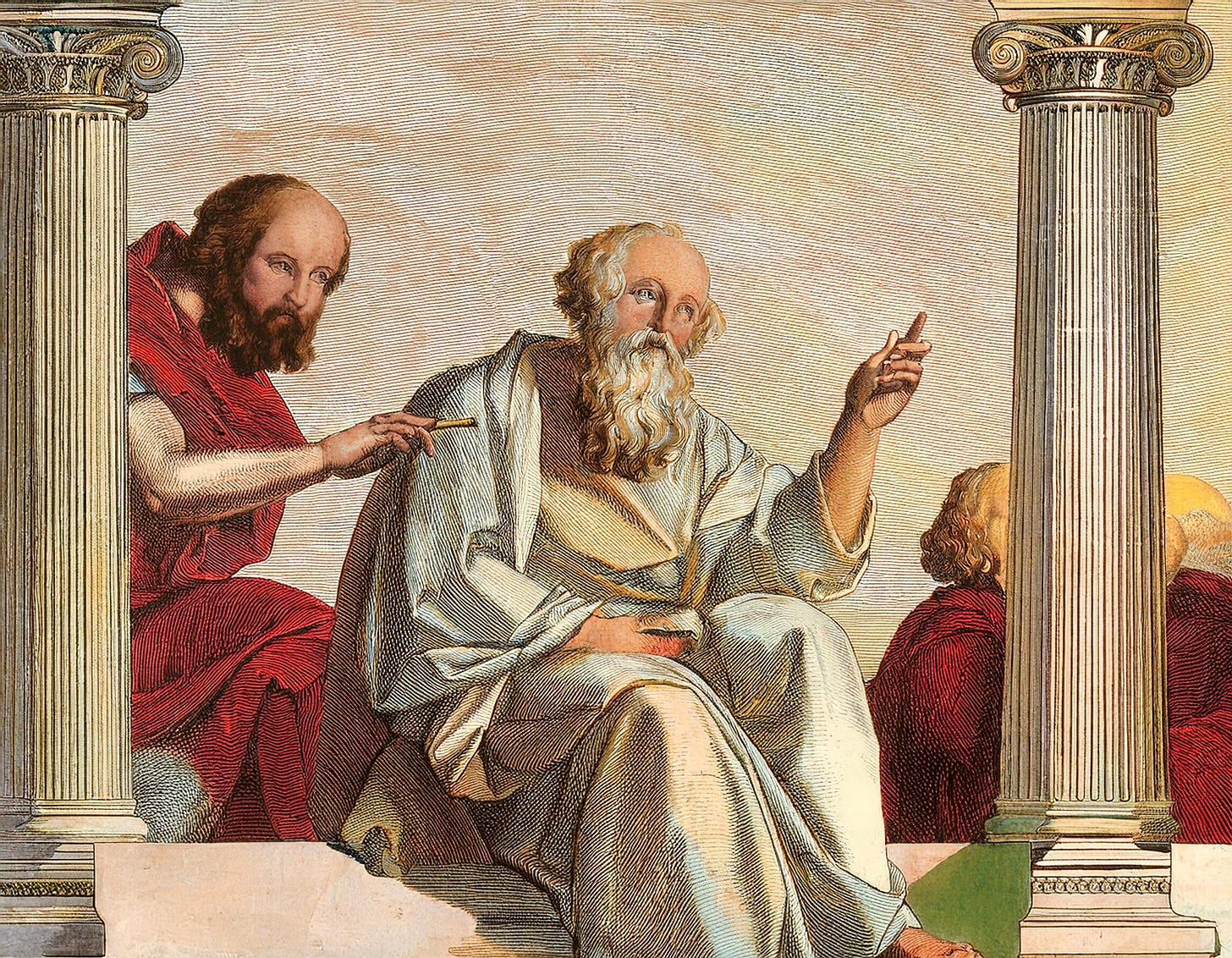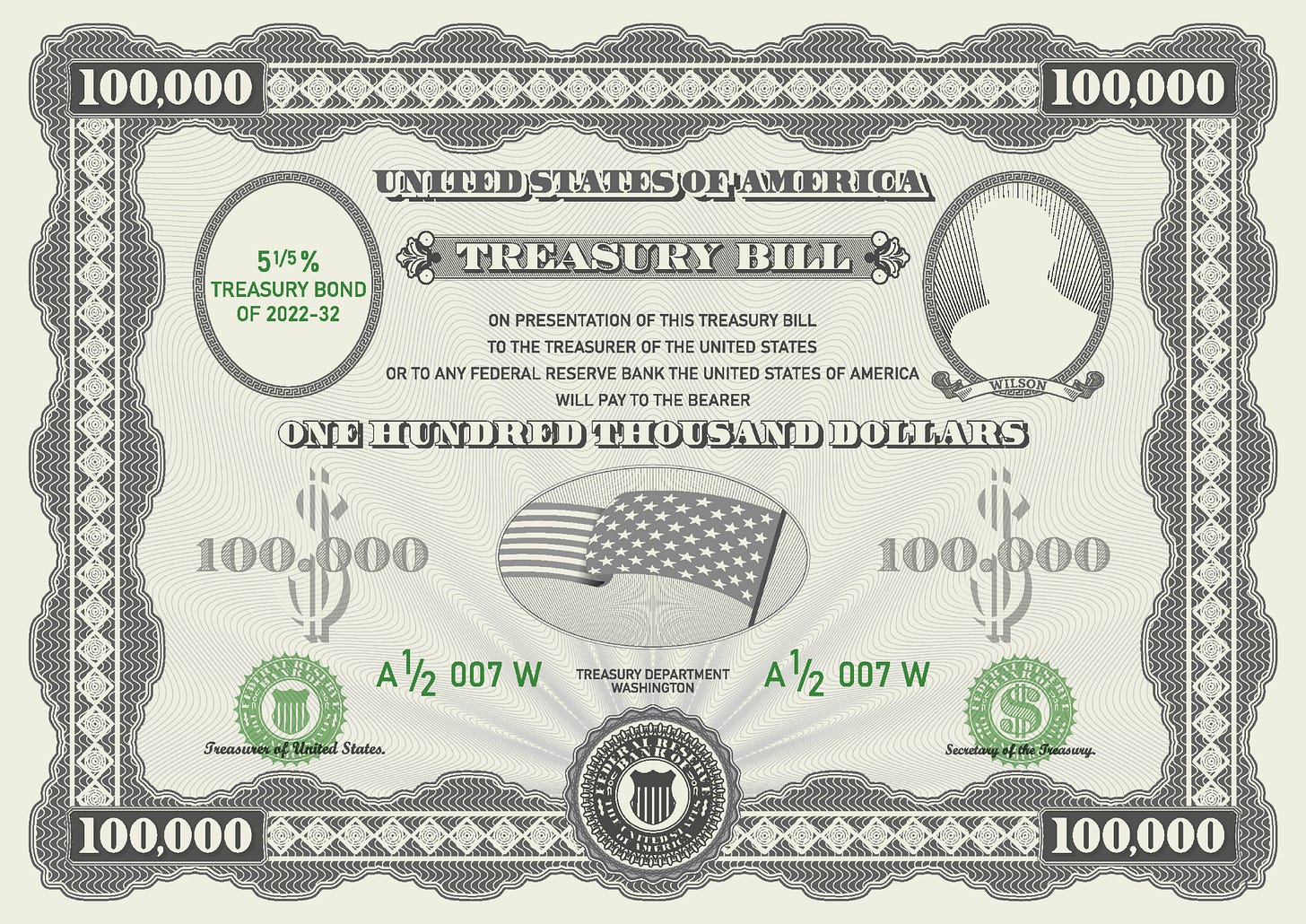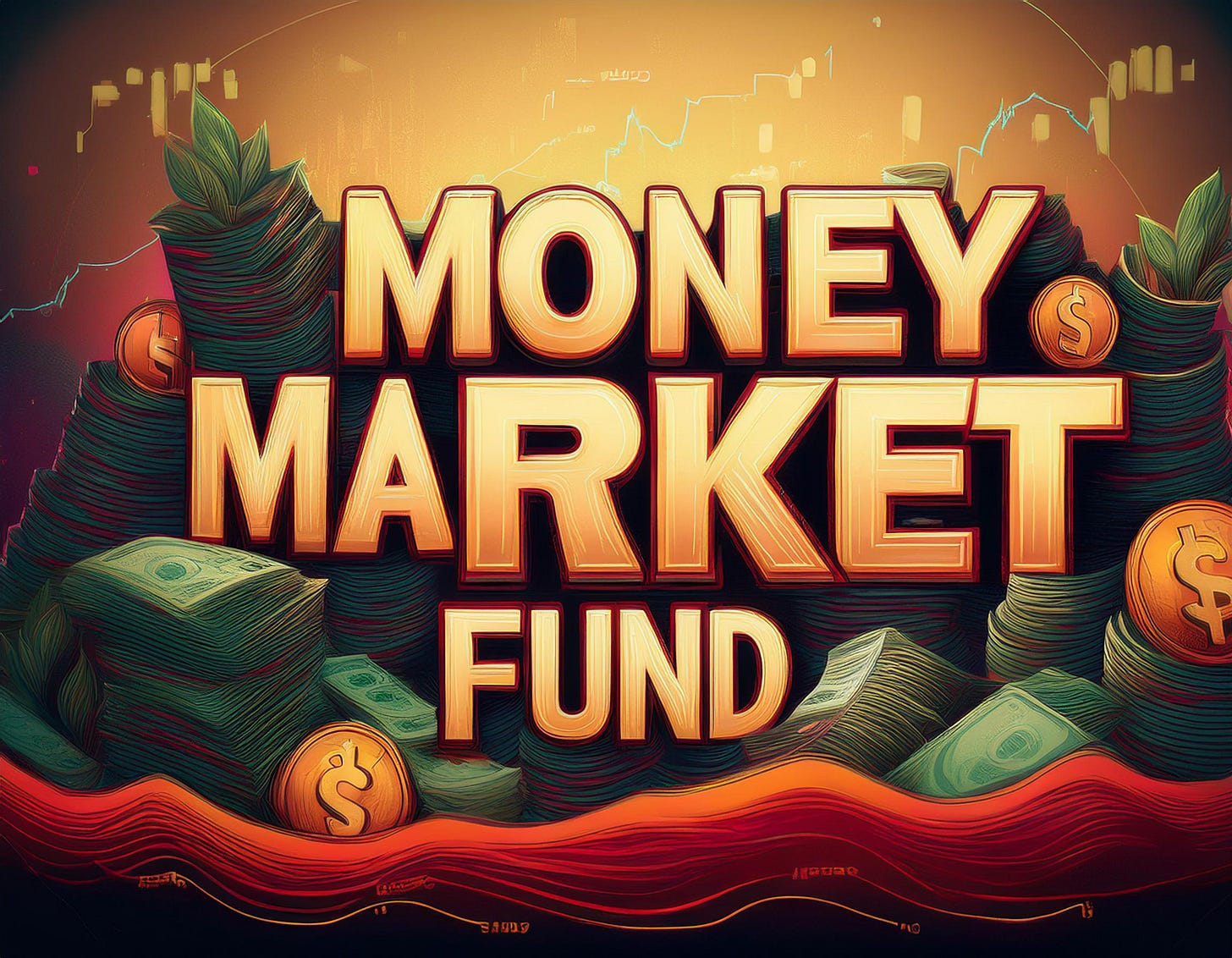Dialogue on Short-term Investments
How Plato and Galileo might use the Socratic Method to explain short-term investments.
Plato and Galileo used what, in recent years, has been called the Socratic Method, a series of questions—in the form of a Dialogue—to help students explore their beliefs and think critically.
We wanted to cover short-term investments, including money market funds, which, if we do it in a straightforward manner is boring. So, we thought we’d try to do so in the rough format of a Socratic Dialogue.
Here goes.
SHORT-TERM INVESTMENTS
PERSONS OF THE DIALOGUE
NOVI, a novice investor.
PROFESSOR, a wise teacher of investment topics.
SAM, a representative of the U.S. Treasury.
YOUNG, a representative of the Federal Farm Credit Bureau.
BANKSY, a banker (or possibly mysterious street artist).
MARY MARGARET FITZGERALD, a purveyor of money market funds.
SCENE: The Investment Store
As Novi is about to enter The Investment Store, she notices the Professor walking toward her.
Novi. Hello Professor, it’s a pleasant surprise to see you here.
Professor. Hello Novi. I’m on my way to the Guru Store to see if they can sync my phone and tablet.
Novi: Good luck with that.
Professor. No kidding. And you?
Novi. I was thinking about making some short-term investments and you said I should make sure I understand anything I’m investing in.
Professor. Quite true. And do you remember the key goals for a short-term investment that we talked about?
Novi. Of course. First, preserve your principal and second, try to stay up with inflation.
Professor. Excellent. I have some time before my appointment. Would you like for me to join you.
Novi. That would be great.
Sam
Novi and the Professor are welcomed by the greeter and asked to take a seat. Soon, a man with red and white striped pants, a red bow tie, and a red, white, and blue top hat approaches.
Sam. Hello, my name is Sam and I’m here to represent the U.S Treasury. I understand you are looking for a short-term investment.
Novi. Yes. Nice outfit by the way.
Sam. It’s supposed to help me stand out.
Novi. It certainly does that. What I’m wanting to do is buy some investments for my emergency fund. I have some money I don’t expect to use for a year or so but would like to know I can access it if needed. Do you have anything that fits that description?
Sam. Yes, of course. I would recommend a 1-year U.S. Treasury Bill.
Novi. How does that work?
Sam. Well, you’d be loaning the U.S. Government money for one year and we would pay you back with interest. Technically, you would tell us how much you want to receive a year from now—that’s the face amount—and we would sell it to you at a discount, depending on the current yield we’re offering.
Novi. So, the yield is roughly the percent return I would make over one year, correct?
Sam. Yes.
Novi. What is the yield on a 1-year Treasury Bill now?
Sam. Currently, it’s 4.20%. If you bought a $1,000 face amount T-Bill, you would pay $959.70 and receive $1,000 a year from now. The difference between the discounted price you pay now and the $1,000 you’ll receive a year from now—that is $40.30—is the amount of interest you receive. If you divide the $40.30 in interest you receive by the $959.70 you invested, it equals the 4.20% return. Would you like me to show you the formula for determining the price?
Novi. No thanks. So, what if I decide I want my money back sooner?
Sam. U.S. securities are highly liquid. You can sell them at any time before their maturity.
Novi. Is there any chance you won’t pay me back?
Sam (sounding somewhat offended). The U.S. government has never defaulted on our debt. It is unthinkable.
Novi. OK, well thanks for your information.
Sam. You’re welcome. If you’re ready to buy a Treasury Bill, I’ll show you how to use Treasury Direct.
Novi. I’ll let you know. Thanks.
Professor. Did that make sense?
Novi. Yes, I believe so. He was a bit touchy when I asked if there’s any chance the U.S. Government wouldn’t pay me back.
Professor. Treasury Bills are backed by the full faith and credit of the United States, meaning the government guarantees that interest and principal payments will be paid on time.
Novi. That sounds pretty safe.
Professor. It is, but it’s worth noting that the long-term credit rating of the U.S. Government was lowered in 2023 by two of the three large credit rating services from AAA, the highest rating, to AA+. By comparison, government debt of Australia and Canada are AAA rated.
Young
At that moment, the Greeter arrived and asked Novi if she would like to speak to someone who could offer a slightly higher yield than Sam had. Novi said yes and they were introduced to Young.
Young. Hello Novi, my name is Young MacDonald and I represent the Federal Farm Credit Bureau, or FFCB.
Novi. You’re not the . . .
Young. No, that was my grandfather. But I’m still carrying on the family tradition of working in the farming industry. So, how can I help you?
Novi. Do you have any investments similar to U.S. Treasury Bills?
Young. Of course. We have Agency Discount Notes which are discount securities and work exactly like Treasury Bills.
Novi. What is the yield you offer?
Young. We typically offer discount notes at a slightly higher yield than what the U.S. Government is offering.
Novi. How come?
Young. Well, our investments—discount notes and longer-term bonds—are not backed by the full faith and credit of the U.S. Government, but, as a Government Sponsored Enterprise, or GSE, we are considered to have the implicit guarantee of the government.
Novi. So pretty safe then.
Young. Most definitely.
Novi. And can I get my money back early if I need it?
Young. U.S. Agency securities are highly liquid and you can easily sell them for cash, if needed.
Novi. Well, thank you for your time. I’ll let you know if I decide to invest.
Young. You’re most welcome.
Professor. Can you name any other government agencies.
Novi. I’ve heard of Freddie Mac.
Professor. Yes, that’s the nickname of the Federal Home Loan Mortgage Corporation. Other GSEs include the Federal National Mortgage Association (Fannie Mae), the Government National Mortgage Association (Ginnie Mae), the Student Loan Marketing Association (Sallie Mae), the Federal Agricultural Mortgage Corporation (Farmer Mac), and the Federal Home Loan Bank (FHLB).
Novi. How come the Federal Home Loan Bank doesn’t have a cool nickname?
Professor. Good question. I’m not really sure.
Novi. So, all of these GSEs offer investments that pay a slightly higher yield than the U.S. Government.
Professor. Yes, that’s true.
Novi was next visited by representatives of a couple of corporations, offering their versions of discount securities called Commercial Paper. These were offered at higher yields still than the Treasury Bills or Agency Discount Notes, depending on the credit rating of the company.
Banksy
Next, Novi was approached by a man wearing a smart suit with a lapel pin.
Banksy. Hello Novi, my name is Banksy.
Novi. You’re not the mysterious street artist, are you?
Banksy. You never know. Oh, of course not. They just thought the name was cool and would help connect with a younger, hip customer group.
Novi. You might want to lose the pin then.
Banksy. Good point. So, how can I help you?
Novi. I’m looking for some short-term investments. What can you offer?
Banksy. Might I suggest a certificate of deposit, or CD for short? We offer them at various maturities out to five years. We can offer competitive yields, typically higher than the government, agency, and even some corporate offerings.
Banksy pulled out his phone and showed Novi a picture.
Banksy. Check out my latest street art.
Novi. Yeah, definitely not The Banksy then.
Banksy. I’m afraid art never was my thing. And now that I look at it I’m worried people will think we’re pushing compact discs. And I should have made the S smaller.
Novi. At least you tried. Is there a catch to buying a Certificates of Deposit?
Banksy. Well, it is true that there have been a number of bank failures, especially during and shortly after the global financial crisis of 2008. So, it is important to look at the creditworthiness of any bank you do business with.
Novi. Aren’t bank deposits insured.
Banksy. Yes, the FDIC currently insures deposits up to a maximum of $250,000.
Novi. Well, that’s good. I’m not investing that much. What about getting my money back early if I need it.
Banksy. Ah well, that could be a bit of a problem. In order to offer higher yields, it helps if we know you won’t be taking your money out early. If you do, we generally charge a penalty for early withdrawal. I’m sure you understand.
Novi. I suppose so, but that could be a problem.
Banksy. Of course.
Novi. Well, thank you. I’ll let you know if I decide to buy any CDs.
Banksy. You’re welcome.
MMF
Novi thought she was through, but there was one more representative to meet.
MMF. Hello Novi, I’m Mary Margaret Fitzgerald but you can call me MMF for short. I’d like to talk to you about money market funds.
Novi. Hence the MMF?
MMF. Yes, it’s convenient.
Novi. So, what type of investment is a money market fund?
MMF. It’s a mutual fund that owns money market instruments like Treasury Bills, Agency Discount Notes, Commercial Paper, and a few others. Basically, we do all the work of comparing yields, checking credit ratings, and buying and selling for you. Some special accounting rules ensure that the price of a money market fund never changes, meaning you can’t lose money. It’s very rare for a money market fund to fail but, like every investment, you should make sure you’re dealing with a quality company.
Novi. Who sells money market funds?
MMF. Brokerage firms, mutual fund companies, and even some banks.
Novi. What if I need to get my money out early?
MMF. No problem. Money market funds are highly liquid.
Novi. Do you charge a fee?
MMF. Yes, but the fees on money market funds tend to be very low.
Novi. Great. Thank you for explaining everything to me.
MMF. You’re welcome.
What Novi Learned
Professor. Well, Novi, what do you think?
Novi. It was a lot to take in but at the end of the day most of the investments seem pretty similar, just with different names.
Professor. True.
Novi. It seems like investing in a money market fund might be the best way to go. It’s certainly less complicated.
Professor. I would agree. You no doubt have at least one money market fund option available in your 401(k) plan and you can easily buy them in any investment account you set up.
Novi. Yes, I think I remember seeing a money market fund but wasn’t really sure what it was.
Professor. Now you know.
Novi. So, it seems the only real risk with a short-term investment is credit risk, or the risk of default.
Professor. That’s definitely a risk worth keeping an eye on, but do you remember when we asked the question which is the least risky, a money market fund or a stock index fund?
Novi. Oh yeah. It had something to do with time didn’t it.
Professor. Yes. Over a short time period, money market funds are definitely less risky than stocks. A diversified stock index like the S&P 500 can be expected to lose money roughly one in every four years. But what if you’re investing for, say, 20 years?
Novi. If I remember, you said that stocks have never lost money over a 20-year or longer period.
Professor. That’s true. And, more importantly, stocks have never had a lower return than money market funds over any 20-year or longer period. Which means?
Novi. Stocks are the least risky asset in the long run. Money market funds are the most risky because they reduce your chance of achieving your long-term investment goals.
Professor. Very good.
Novi. Is there anything else I should know.
Professor. There’s always more to know. But for now, I’ll mention that if you have a short-term portfolio—money you’ll need in 3 to 5 years—you may want to use some mix of money market instruments and short-term bonds. Unfortunately, it’s about time for my appointment so we’ll have to cover this more later.
Novi. Thanks Professor. Oh, and good luck getting your phone and tablet synced.
Professor. Let’s hope. Have a good day Novi.
Novi. You too, Professor.
So, there you go. Our first attempt at a Socratic Dialogue. Let us know what you think. We’re considering including a Dialogue at the end of each chapter in The Practice of Investing book in order to add a way to clarify some of the issues in each chapter.
Best regards,
Stuart & Sharon







